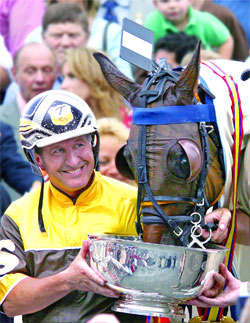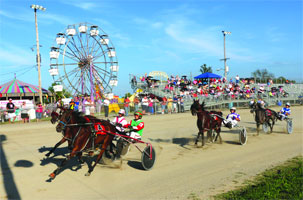
Arguably, harness racing's most popular event is the Hambletonian (often referred to as the Hambo), a nationally televised, elite trotting race that takes place in August at Meadowlands Racetrack. The race features the top 3-year-old trotters in the sport, racing for more than a million dollars in purses.
Named after the foundation sire of the Standardbred breed, the Hambletonian has been held every year since 1926, and contested at the Meadowlands since 1981.
One of harness racing's most hallowed events is the Little Brown Jug, a premier race for 3-year-old pacers, which is contested every September in Delaware, Ohio. Horsemen and fans (usually between 40,000-50,000) travel from all over the world to see this iconic race, which has been happening for 70 years, and it only takes one magical, summer afternoon in the grandstand to see why.
Unlike most races, horses competing in the Little Brown Jug are required to win two races on the same day before being crowned champion. This definitely makes things more challenging, and many fans would argue, even more exciting.
For one weekend in late fall, the top trotters and pacers of all ages meet in the Breeders Crown to compete for more than $5 million in purses. The horses are grouped by age, gait and gender. The winners of each Breeders Crown race are generally considered to be the best in their class.

In the early days of harness racing, county fairs provided an ideal venue for friends and neighbors to race their horses against one another.
As time has passed, county and state fair harness racing has remained. More than 200 fairs in 22 states host harness racing, giving novice horses and horsemen a chance to get some experience before heading to the bright lights and fast pace of a pari-mutuel racetrack. While many fair races are designed with beginners in mind, there are also several Grand Circuit races that take place at prominent fairgrounds around the country. Like NASCAR, the Grand Circuit is a series of races that are contested at different racetracks, both at fairs and pari-mutuel tracks.
A trip to watch county fair racing is a rewarding experience that shouldn't be missed. For more information about fairs in your area, visit Fairs.ustrotting.com.
While the very best gather for racing's biggest events, there are races being held almost every day of the year, for horses of every level of talent and speed. Those major races are called "stakes" races, while the everyday races are called "overnights." The difference lies in when each horse's owner decides to enter them in that race.
In stakes races, the owners of the horses make periodic payments long before the horse ever makes it to the races; they are putting up "stakes" that their horse will someday race in that major event and make their owners' money back along with thousands of dollars more.
In overnight races, owners enter their horse in that race just a few days before, with no entry fee. They race for a purse; meaning the prize pool for the race; made up of revenue generated by wagering on other races, and in some states, a percentage of the revenue generated by the video lottery terminals in place at the track.
Overnight races can be divided into conditioned races, meaning the horse is classified by how many races it has won or how much money it has or hasn't won recently. The top level of overnights might be called an Open, or Invitational, or Free-For-All, and is for the track's best horses. Horses in claiming races are all for sale for that amount. Owners go into a claiming race knowing that someone else can buy that horse from them for that price.